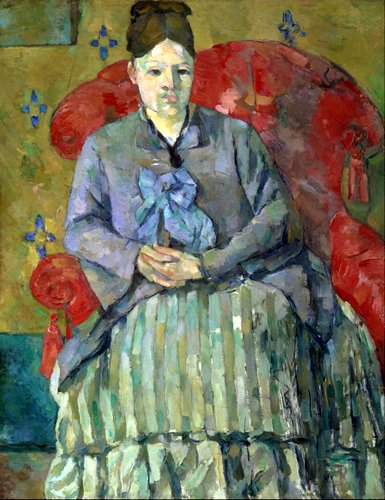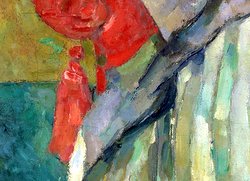|
KYSO Flash ™
Knock-Your-Socks-Off Art and Literature
|
|
|||
Paul Cézanne’s Madame Cézanne in a Red Chairby Charles D. Tarlton
1 So far, all that can be established with any certainty is that there was an artist living in Paris in 1905 who painted variously under the names Cézanne, Matisse, and Picasso. Right away, you recognize the shared and regular form of the names: consonant, vowel, followed by a consonant, and then a construction made up of one vowel, followed by two consonants, and a final vowel! Only the one—Cézanne—employed the accent aigu, a clever ruse. Such strategies are well known by those who study the adoption of aliases, devices for jarring memory. But, of course, the similarities do not end there. Available from galleries all over the city were portraits that displayed such commonalities that only the most stubborn critic would fail to see the resemblance. All three employed oriental patterns in wallpaper or fabrics, an unrealistic style in which the faces of the sitters were flattened and patently two-dimensional. While the clothing was more carefully rendered in shadowed three dimensions, the faces all were bland and expressionless, and finally, the edges of things were outlined in black.
my eye cannot leave
cubist nose. The green
everything depends
2 Here’s a crucial question: does the idea for a portrait arise first in the mind of the subject or out of the needs of the painter? In the first instance, there is a good chance the painter will abide by bourgeois considerations and make the portrait resemble the subject. In such cases, after all, money is changing hands. In the second instance, the model’s desires are irrelevant; the artist is likely testing a theory, experimenting with a technique or a color, or folding the figure into some larger set of artistic motives. Toward the end, using the nom de plume Picasso, our Parisian artist collapsed such categories and pushed unrecognizability to its ultimate extreme (all in the interest, of course, of seeing more completely), making all his portraits radically cubist (his daughter Maya, the one of Dora Maar, or The Woman in a Red Armchair) with noses bent and eyes on each side of their heads.
all art is one thing
visiting the dead
listen! You can hear 3
Seated in this red armchair, which is a personality in its own right, is a woman, her hands in the lap of a dress with broad vertical stripes.... In the brightness of the face, the proximity of all these colors has been exploited for a simple modeling of form and features: even the brown of the hair roundly pinned up above the temples and the smooth brown of the eyes has to express itself against its surroundings.
We were moving to the Orne, in France, where we had bought a little house near a large dairy farm. We had shipped only a few pieces of furniture over, so all at once we were in the market for just about everything—bed, bookcases, dining room table, sofa. We found a great long table at a brocante, bookcases in unfinished pine at Conforama, the bed at a vide grenier; and we found (or rather I did; Ann was never enamored of it) a classic red French settee. Well, the fabric was mainly red, with the occasional stripe of yellow or pale green. We hauled it from France back to California and then, six years later, to Massachusetts where there was no room for it; so rather than sell it, I gave it to one of the lawn-mowing crew members who hauled it away in a pickup for his wife.
feel the period
she wears a white mask
Madame’s hair parted
Publisher’s Notes:
|
|
Site contains text, proprietary computer code, |
|
| ⚡ Many thanks for taking time to report broken links to: KYSOWebmaster [at] gmail [dot] com ⚡ | |

